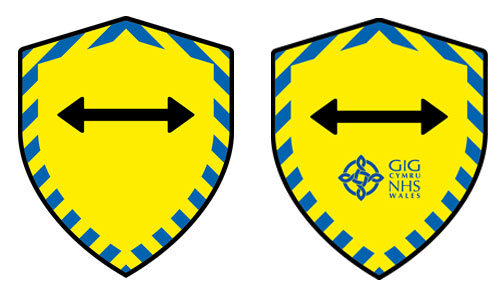Your letters
Dear Editor
Shielding and ‘wanting others to keep their distance’ – an online survey
As COVID-19 lockdown measures are eased, there is significant anxiety among some groups about decreasing adherence to social distancing. The initial clear ‘2 m rule’ has now been reduced to ‘1 m plus’ in England, with increasing confusion about the guidance. One of the authors, who is shielding, has particular concerns about respect for personal space. A recent publication proposed a ‘Safer at 2 m’ lapel badge to prompt effective social distancing [1], and the overwhelmingly positive response led us to perform a national survey around self-identification with a recognisable symbol on a badge/ pin.
We circulated a questionnaire using Google Poll® between 25 June and 5 July, with eight questions exploring views on concept, design and application. This was shared widely on social media, and 1765 responses were received (Table 1).
None of the proposed designs were favoured outright, but the NHS branded shield design was marginally the most popular of those put forward by 485/1725 (28%). Free-text feedback around the design identified that the symbol needed to be a contrasting colour combination to be easily noticeable, with concerns that modification of an already existing symbol could lead to confusion. There were also concerns relating to the presence of text that might encourage people to come close in order to read it.
The high number indicating that they would respect a badge is one of the most important results of the survey as it showed a willingness to engage from both shielding and non-shielding groups, although the results are open to considerable response bias.
Overall the ability to self-identify with a consistent, recognisable symbol was welcomed. Whilst the need for ongoing social distancing is well known, there is a willingness from the public to engage in the use of polite prompts to maintain this behaviour. With this in mind, the authors have taken the data to local and national governments for consideration of a national scheme. To date the Welsh Government has endorsed an NHS initiative, supported by registered charities and discussions are ongoing with other governments. The ‘Distance aware’ shield (Figure 1) is now being adopted by individuals and organisations nationwide as a positive symbol for ongoing social distancing.
Helen A. Iliff
Anaesthetics Core Trainee
Department of Anaesthesia and Critical Care, Cwm Taf Morgannwg UHB
Bevan Exemplar, Wales
Baroness Ilora Finlay of Llandaff
House of Lords
Bevan Commissioner, Wales
Malcolm G. Semple
Professor of Outbreak Medicine
Institute of Infection Veterinary and Ecological Sciences, University of Liverpool
Twitter: @iliff_helen; @TweedieChap
References
1. The bmjopinion. How can “shielding” be safely lowered as lockdown is eased?, 22 June 2020. https://blogs.bmj.com/bmj/2020/06/22/how-can-shielding-be-safely-lowered-as-lockdown-is-eased/ (accessed 29/7/2020).
Table 1
| I am:
|
| shielding self
|
880/1749 (50%)
|
| shielding another or by proxy
|
223/1749 (13%)
|
| non-shielding
|
646/1749 (37%)
|
| A badge or lapel pin that could be worn to self-identify as wanting one’s social space respected is a good idea
|
1584/1743 (91%)
|
| A badge/ pin could help those who feel vulnerable during transition into the ‘new normal’
|
1650/1744 (95%)
|
| A consistently recognisable symbol is important
|
1662/1735 (96%)
|
| I would respect someone’s social space and keep my distance if I saw a badge or pin that I recognised
|
1724/1745 (99%)
|
| Non-shielding: I would wear a badge or symbol that promoted ongoing social distancing
|
329/635 (52%)
|
| Non-shielding: I would consider wearing a badge or symbol that promoted ongoing social distancing
|
173/635 (27%)
|
Figure 1

Congratulations to Helen A. Iliff for winning October's Letter of the Month prize.